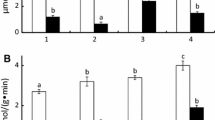Abstract
It is shown that the level of total amylolytic activity (TAA) in the whole organism of potential preys (belonging to various taxonomic groups) of planktivorous and benthivorous fishes, as well as in the associated microbiota, depends largely on pH values in a medium. Maximal values of TAA in all species of invertebrates and in the micro flora isolated from their bodies are observed at pH 7.0; minimal ones are found at pH 10.0. The microbiota of Dreissena and of crustacean plankton may efficiently depolymerize polysaccharides within the zone of acid pH values.
Similar content being viewed by others
References
Bogatyrenko, E.A., Characteristics of cultured heterotrophic microbial community from the intestine of the Far Eastern sea cucumber Apostichopus japonicus, Extended Abstract of Cand. Sci. (Biol.) Dissertation, Vladivostok, 2013.
Golovanova, I.L., Analysis of mono-, bi-, and multifactor effects of temperature, pH, and cadmium on the digestive carbohydrases of fish, Biol. Vnutr. Vod, 1997, no. 2, pp. 58–64.
Golovanova, I.L., Influence of natural and anthropogenic factors on the carbohydrase activity of juvenile fish, Biol. Vnutr. Vod, 2000, no. 1, pp. 132–137.
Golovanova, I.L., Individual and combined effects of temperature, pH, and heavy metals (Cu, Zn) on the activity of intestinal carbohydrases of fish, Toksikol. Vestn., 2011, no. 1, pp. 32–35.
Goromosova, S.A. and Shapiro, A.Z., Osnovnye cherty biokhimii energeticheskogo obmena midii (The Basic Characteristics of the Biochemistry of Energy Metabolism in Mussels), Moscow: Nauka, 1989.
Egorov, S.I., Izhberdieva, E.I., and Viyatik, S.V., Studies of Some Digestive Enzymes in Food Items of Fish, Vestn. Astrakhan. Gos.-Tekhn. Univ. Ryb. Khoz., 2000, pp. 120–122.
Zolotareva, G.V., Kuz’mina, V.V., Zalevskaya, T.G., and Sheptitskii, V.A., Proteinase activity of chyme and enteric microbiota in the pH range natural for fish intestine, Probl. Biol. Produkt. Zhivotn., 2013, no. 2, pp. 85–92.
Zubkova, L.A., The bacterial flora of organs and tissues of common carp (Cyprinus carpio L.), Tr. Kasp. NII Ryb. Khoz., 1966, vol. 20, pp. 117–121.
Zubkova, L.A., On the problem of normal micro flora of the Volga pikeperch (Lucioperca lucioperca), Tr. Kasp. NII Ryb. Khoz., 1967, vol. 22, pp. 81–85.
Izvekova, G.I., Izvekov, E.I., and Plotnikov, A.O., Symbiotic micro flora in fishes of different ecological groups, Biol. Bull. (Moscow), 2007, vol. 34, no. 6, pp. 610–618.
Izvekova, G.I. and Plotnikov, A.O., Hydrolytic activity of symbiotic micro flora enzymes in pike (Ecox lucius L.) intestines, Inland Water Biol., 2011, vol. 4, no. 1, pp. 72–77.
Kuz’mina, V.V., Evaluation of multifactor effects on the activity of proteases of the fish intestinal mucosa, Biol. Vnutr. Vod, 1997, no. 2, pp. 50–57.
Kuz’mina, V.V., Effect of temperature on digestive hydrolase of aquatic invertebrates, Zh. Evol. Biokhim. Fiziol., 1999, vol. 35, no. 1, pp. 15–19.
Kuz’mina, V.V., Contribution of induced autolysis to digestion in secondary consumers (exemplified by hydrobionts), Dokl. Biol. Sci., 2000, vol. 373, pp. 379–381.
Kuz’mina, V.V., Fiziologo-biokhimicheskie osnovy ekzotrofii ryb (Physiological and Biochemical Principles of Exotrophy Processes in Fish), Moscow: Nauka, 2005.
Kuz’mina, V.V. and Skvortsova, E.G., Bacteria of the gastrointestinal tract and their role in digestive processes in fish, Usp. Sovrem. Biol., 2002, vol. 122, no. 6, pp. 569–579.
Kuz’mina, V.V. and Ushakova, N.V., Activities of proteinases in invertebrate animals-potential objects of fish nutrition. Effects of temperature, pH, and heavy metals, Zh. Evol. Biokhim. Fiziol. 2007, vol. 43, no. 5, pp. 405–409.
Kuz’mina, V.V. and Ushakova, N.V., Effects of temperature, pH, and heavy metals (copper and zinc) on the activity of proteases of gastrointestinal mucosa of benthophagous and planctophagous fishes, Biol. Vnutr. Vod, 2007, no. 4, pp. 71–79.
Lubyanskene, V., Verbitskas, Yu., Yankyavichus, K., et al., Obligatnyi simbioz mikroflory pishchevaritel’nogo trakta i organizma (Obligate Symbiosis of the Digestive Tract Micro flora and the Organism), Vilnius: Mokslas, 1989.
Plisetskaya, E.M., Gormonal’naya regulyatsiya uglevodnogo obmena u nizshikh pozvonochnykh (Hormonal Regulation of Carbohydrate Metabolism in Lower Vertebrates), Leningrad: Nauka, 1975.
Ugolev, A.M., Evolyutsiya pishchevareniya i printsipy evolyutsii funktsii (Evolution of the Digestive System and the Principles of Function Evolution), Leningrad: Nauka, 1985.
Ugolev, A.M. and Iezuitova, N.N., Determination of the activity of invertase and other disaccharidases, in Issledovanie pishchevaritel’nogo apparata u cheloveka. Obzor sovremennykh metodov (Study of the Digestive Tract in Humans: An Overview of Modern Methods), Leningrad: Nauka, 1969, pp. 169–173.
Ugolev, A.M. and Kuz’mina, V.V., Pishchevaritel’nye protsessy i adaptatsii u ryb (Digestive Processes and Adaptation in Fish), St. Petersburg: Gidrometeoizdat, 1993.
Shivokene, Ya.S., Simbiontnoe pishchevarenie u gidrobiontov i nasekomykh (Symbiotic Digestion in Aquatic Organisms and Insects), Vilnius: Mokslas, 1989.
Barrington, E.J.W., The alimentary canal and digestion, in The Physiology of Fishes, New York: Acad. Press, 1957, vol. 1, pp. 109–161.
Buddington, R.K., Krogdahl, A., and Bakke-Mckellep, A.I., The intestines of carnivorous fish: structure and functions and relations with diet, Acta Physiol. Scand., 1997, vol. 161, suppl. 638, pp. 67–80.
Fange, R. and Grove, D., Digestion, in Fish Physiology, New York: Acad. Press, 1979, vol. 8, pp. 162–260.
Kuz’mina, V.V., Skvortsova, E.G., Zolotareva, G.V., and Sheptitskiy, V.A., Influence of ph upon the activity of glycosidases and proteinases of pH intestinal mucosa, chyme and microbiota in fish, Fish Physiol. Biochem., 2011, vol. 37, no. 3, pp. 345–357.
Mattheis, Th., Ökologie der Bakterien in Darm von susswassernuttfishen, Z. Fisch., 1964, vol. 12, pp. 6–10.
Richter-Otto, W. and Fehrmann, M., Zur methodik von darmflora untersuchungen, Ernahrungsforschung, 1956, vol. 1, pp. 584–586.
Author information
Authors and Affiliations
Corresponding author
Additional information
Original Russian Text © V.V. Kuz’mina, G.V. Zolotareva, V.A. Sheptitsky, 2015, published in Biologiya Vnutrennikh Vod, 2015, No. 2, pp. 85–90.
Rights and permissions
About this article
Cite this article
Kuz’mina, V.V., Zolotareva, G.V. & Sheptitsky, V.A. The in vitro effect of pH on glycosidase activity in potential preys of planktivorous and benthivorous fish. Inland Water Biol 8, 182–187 (2015). https://doi.org/10.1134/S1995082915020108
Received:
Published:
Issue Date:
DOI: https://doi.org/10.1134/S1995082915020108



